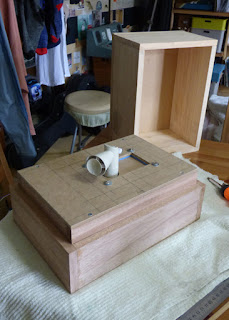Part 2
Concrete
We live in a small 'council flat' in Tokyo. There are neighbours above, below and to either side. They're decent folk and I don't want to push it by making too much noise. Nonetheless, I'm sure I disturb them from time to time with my music and DIY activities. They probably can't tell the difference between the two...
That's one reason to embark on an isolation cabinet. The other is a question of sound balance since I generally do everything at low volume. The problem is I need to have the rotary speaker significantly louder in order to mic it up to get a healthy signal into the mix. Therefore, unless the speaker is in another room (which I don't have), it will just drown everything else out. This got me thinking that perhaps an isolation cabinet could be the answer?
There are acoustic challenges with this approach - not least the way an enclosed space (unless expertly designed) affects the sound in an undesirable way. Typically the sound becomes 'boxy'. My approach was to just go ahead anyway, see if I could figure out ways to limit such issues and hopefully learn something along the way. I've made some attempt to incorporate 'the science', but not too much as that would probably have resulted in me abandoning the project!
Here's the enclosure - the wood surround has a thickness of 15 mm. The top and bottom surfaces are MDF (not quick as thick).
With the top removed showing the speaker/motor unit mounted inside. There's a layer of neoprene rubber in between to help cushion vibrations as it spins
Seen from below...
By itself, the wood doesn't do much to stop sound escaping, so the next step was filling the interior with concrete. First, I lined the enclosure with carpet. This mainly helps the concrete key to the inner surface and the rubber backing should help avoid vibrations...well, that's the theory. I inserted short lengths of dowel to provide further support since this section will be turned 'upside down' when placed over the speaker.
I set an initial layer of concrete as a base inside the two parts of the enclosure. On the left is the lower part. The plastic pot is there to form a space that will accommodate the back of the speaker and a short length of garden hose through which cables will eventually run.
Additionally, I set some screws into the wet concrete. These protrude so that when the next layer of concrete is poured, they provide some extra support.
The next step was to make a former for the cavity in which the rotor will turn. The elongated shape allows for a microphone to be position some distance from the spinning rotor, while the flat end creates a 'reflective' surface for the sound to bounce off.
The second pour...
In all, I used around 10kg of concrete. With all other parts, including the speaker and motor, the whole thing weighs in at just under 17kg.
The concrete had several weeks of curing before I moved on to the next stage but in part 3, I'll show how I finished the enclosure and hopefully post a video to demonstrates how it cuts down the sound to the outside world.













Comments
Post a Comment